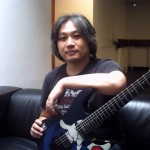This is it! The third Console Wars focused episode of the SEGAbits Swingin’ Report Show in which Barry and George speak with the man himself, SEGA of America’s former President Tom Kalinske! Tom has an amazing history with the toy and game industry. Before his years with SEGA, Tom served as President and CEO of Mattel, reviving the Barbie brand and creating the He-Man and the Masters of the Universe line. During his time at SEGA, Tom reinvigorated the SEGA Genesis brand, helped in the creation of Sonic the Hedgehog, and led the launch of many famous pieces of SEGA hardware including the Game Gear, Pico, 32X, Nomad, and Saturn.
Tom Kalinske’s career is chronicled in the book “Console Wars: Sega, Nintendo, and the Battle that Defined a Generation” by Blake J. Harris, and if you haven’t purchased a copy yet, do so today. If you’ve read the book, are reading the book, are awaiting delivery of the book, or are simply a fan of SEGA during the 90’s, this show is a must listen!
Also, make sure to check out the other Console Wars interviews including a discussion of SEGA’s marketing efforts with SEGA’s former Director of Marketing Al Nilsen and an interview with the author of Console Wars, Blake J. Harris.
[Download] [RSS] [iTunes] [Archive]
Interview
Interview: Al Nilsen, SEGA’s Director of Marketing (’89-’93), appears on the SEGAbits Swingin’ Report Show
Al Nilsen, SEGA of America’s Director of Marketing from 1989 through 1993, sat down with Barry and George on the latest SEGAbits podcast to talk about the glory days of the SEGA Genesis. Al and his team were behind everything, including promoting the famous “Genesis Does What Nintendon’t” campaign, the creation of Sonic the Hedgehog, implementing the legendary “Sonic 2sday” worldwide launch of Sonic the Hedgehog 2 in 1992, and rolling out the “Welcome to the Next Level” campaign.
Al’s appearance is in anticipation of the release of “Console Wars: Sega, Nintendo, and the Battle that Defined a Generation” by author Blake J. Harris, which you can pre-order today from Amazon.com. “Console Wars” tells the story of SEGA vs. Nintendo during the early 90′s, as told from the perspective of SEGA of America president Tom Kalinske. Based on over two hundred interviews with former SEGA and Nintendo employees, “Console Wars” is the underdog tale of how Kalinske miraculously turned an industry punchline into a market leader. It’s the story of how a humble family man, with an extraordinary imagination and a gift for turning problems into competitive advantages, inspired a team of underdogs to slay a giant and, as a result, birth a $60 billion dollar industry.
Expect more “Console Wars” content throughout May, including a podcast with the author Blake J. Harris next week, and a podcast with Tom Kalinske the week after that!
[Download] [RSS] [iTunes] [Archive]
SEGAbits Swingin’ Report Show Interview with Sonic Boom Producer Stephen Frost
Hot on the heels of the reveal of the new Western television series and video game Sonic Boom, SEGA of America producer Stephen Frost sat down with SEGAbits Swingin’ Report Show hosts Barry and George, as well as David of Sonic Retro, to discuss all things speedy and blue. In this hour long discussion we delve into the genesis of the project, learn more of the team at Big Red Button Entertainment, and get a few hints at what we can expect to see in both the game and show. If Stephen’s enthusiasm is any gauge for what we can expect, we’re in for a real treat later this year!
Learn more about the new branch in the Sonic franchise at the official Sonic Boom website.
[Download] [RSS] [iTunes] [Archive]
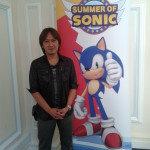 Over the past few years the Sonic series has hit a bit of a renaissance, with Colours and Generations achieving relative success critically as well as commercially. Typically, just as this turnaround is achieved, the newest game shows signs of radical change to the 3D Sonic formula that had finally gained acceptance. Sonic Lost World’s new design is the kind of decision that means it’s always interesting to chat to Takashi Iizuka, the man at the top of Sonic Team today and the public face of the team. He’s always cheery and approachable, but you can never quite predict the answers you’ll get from him. We caught him right at the beginning of Summer of Sonic, as the organisers were on stage welcoming attendees!
Over the past few years the Sonic series has hit a bit of a renaissance, with Colours and Generations achieving relative success critically as well as commercially. Typically, just as this turnaround is achieved, the newest game shows signs of radical change to the 3D Sonic formula that had finally gained acceptance. Sonic Lost World’s new design is the kind of decision that means it’s always interesting to chat to Takashi Iizuka, the man at the top of Sonic Team today and the public face of the team. He’s always cheery and approachable, but you can never quite predict the answers you’ll get from him. We caught him right at the beginning of Summer of Sonic, as the organisers were on stage welcoming attendees!
[Sonic Retro sits down at one end of the large room, with Iizuka and Sega’s interpreter. At the other end, Jun Senoue is faintly strumming away on his guitar, playing the Station Square music. When asked which site we’re from, the reply elicits the customary “Ah, Sonic Retro” from Iizuka.]
Retro: We’re seeing Sonic Lost World at the convention today, and one of the things that is very noticeable is that it goes back to an older, more classic visual feel for the game, with recognisable elements of the original Sonic the Hedgehog design. What motivated you to make this change?
Iizuka: With the previous game (Sonic Generations), it was for the 20th anniversary so we decided to celebrate Sonic’s history. With that one, we tried to compress 20 years of history into one title and aimed for a high quality, HD re-imagining of what Sonic could be. With Sonic Lost World, what we wanted to do was imagine how best Sonic should be going forwards. So we looked back at what we had done before and tried to think about what would the best, playability-wise for Sonic going forwards, and what’s the best look for Sonic.
With Generations, it was HD and really detailed, almost so much that it was hard to see the rings when you were running through the levels. So this time, we stripped everything back and tried to renew Sonic, and we simplified the graphics to match the playability, the style of what Sonic should be.
[Read on for Iizuka’s views on the limitations of Sonic’s previous 3D outings, inspirations for Sonic Lost World and differences between working in the USA and Japan!]
The Sonic the Hedgehog comics, Archie and STC alike, have dedicated followings. One of the people responsible for the comics is Ian Flynn, the chief writer for the Archie series since #160. Recently, he sat down for an interview with the Super Power Flower Hour, a relatively new Sonic-related podcast. He gives his thoughts on the Sonic franchise, working on the comics, the Mega Man comics, and more. Check it out.
 Once upon a summer, your fearless correspondent went to Brighton for Summer of Sonic. There, he braved seagulls, rain and hundreds of other Sonic fans to get interviews with Takashi Iizuka and Jun Senoue. Those, you have seen. What you won’t have seen is the interview with Steve Lycett and Tim Spencer of Sumo Digital. That’s because, erm… we forgot to put it up.
Once upon a summer, your fearless correspondent went to Brighton for Summer of Sonic. There, he braved seagulls, rain and hundreds of other Sonic fans to get interviews with Takashi Iizuka and Jun Senoue. Those, you have seen. What you won’t have seen is the interview with Steve Lycett and Tim Spencer of Sumo Digital. That’s because, erm… we forgot to put it up.
Still, the good news is that because the game is out soon, you can now have all the latest information from July! Naturally the information contained within will be common knowledge, what with the interview having been recorded four months ago and all. However, you can still hear Sumo’s thoughts on designing for multiple vehicle types, testers with Sega knowledge deficits, and theoretical control systems for a version of the game that hasn’t been confirmed to exist at all.
So, what are you waiting for? (What were we waiting for?) Start the player, you!
[display_podcast]
Over the past 21 years, during good times and bad, one of the most consistently well-regarded aspects of the Sonic the Hedgehog series has been its sound design. While a multitude of composers and performers are responsible for this, the man who holds the most influence in the modern era is Jun Senoue, who in recent times has acted as sound director for Sonic Generations and composed the Sonic 4 music.
He’s a man who likes to keep himself busy – if a quick peek at his production history on Sega Retro doesn’t show you that, then consider that at Summer of Sonic he didn’t appear to have a moment of rest between backstage interviews, two signing sessions, Jam with Jun and the Crush 40 set! Thankfully, before the day took its toll I was able to sit down with him to chat about his start in the business, Sonic Generations and the process of making Sonic music in general. Take a look:
Retro: How did you get into writing music, and specifically how did you get into writing music for video games?
Senoue: Actually I was a big fan of Namco stuff, arcade stuff like Mappy from the mid-80s. After that I was a little bit away from video games. In the early 90s I was surprised by Sonic the Hedgehog for the Genesis, the Mega Drive. I joined Sega back in 1993. I just submitted my stuff to Sega and they accepted. I was totally surprised, those were my favourite games! It was a great opportunity to join Sega and luckily I had a chance to be part of Sonic 3’s music in the first year of my Sega life.
Retro: Were there any musicians that inspired you as you grew up?
Senoue: I was a big fan of a UK pop band called Duran Duran, and that was the reason I got a bass when I was 14. The bass player for them looked much cooler than the guitar player! Also I played the keyboard for a long time, but I found that the keyboard player and the drummer stayed at the back side of the stage. The people at the front of the stage were much more active and I just wanted to be a part of that. So I purchased a bass, because of John Taylor from Duran Duran. But after that I found that some guitar players had nice guitar solos in the middle of the songs, and I thought “Oh, that’s what I want to do!” so I switched from bass to guitar when I was 15, 16? So yes, Duran Duran was one of my favourite bands when I was young and also lots of hard rock and hair metal bands.
Hit “Read more” to learn which game spent a year in production without any sound direction and find out Jun’s favourite Sonic songs!
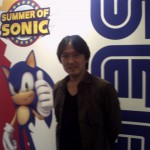 Whether you’re getting your first Sonic game signed or you’re privileged enough to be playing on stage with Jun Senoue, one of the great things about Summer of Sonic is that it’s a chance for fans to connect with the people making the games we care about. Last year I was one of the lucky ones, as I had the great pleasure of interviewing Yuji Naka and Takashi Iizuka for this very site.
Whether you’re getting your first Sonic game signed or you’re privileged enough to be playing on stage with Jun Senoue, one of the great things about Summer of Sonic is that it’s a chance for fans to connect with the people making the games we care about. Last year I was one of the lucky ones, as I had the great pleasure of interviewing Yuji Naka and Takashi Iizuka for this very site.
My luck continued this year. While I might have managed to scare the president and CEO of Prope away from the UK for good (though I’ll fervently deny that in court), Sonic Team’s Takashi Iizuka returned to Summer of Sonic and numbered amongst those who gracefully agreed to face a bout of questions from Sonic Retro. So, on with the show!
Retro: How did you first become involved in the video game industry? Did you work on any games before Sonic 3?
Iizuka: The university I went to was the kind of university where you learned about electronics. Most of the students will have worked with electronics companies like Toshiba and Sony after graduating. The difference was that I wanted to find a fun job, so the only company I went for was Sega! If I didn’t get that, I would have ended up going to a normal electronics company. Sonic 3 was the project that I started in my first year at Sega, but as practice I was involved with Golden Axe 3.
Retro: Sonic Colours and Sonic Generations have received the best reaction of any Sonic games since Sonic Adventure 2, both from critics and fans. What changes do you think explain the positive reactions that have been achieved?
Iizuka: Before Sonic 4 and and Sonic Colours where I was the producer, it seemed that the whole direction wasn’t really in tune. There wasn’t really an idea of how to portray Sonic. When I became producer, I was able to portray Sonic in the way that he really should be portrayed. This may have had an impact on the way the new games have been received.
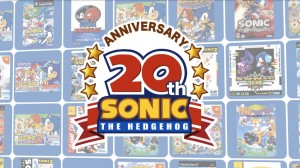 Now that Sonic Generations has arrived for most of the world, the inevitable questions are popping up: what’s next for the Sonic series? We’ve heard already that there are “no plans” for classic Sonic post-Generations (and our inevitable reaction was no doubt heard ’round the Internet), but beyond the upcoming Sonic 4: Episode 2 release next year, there hasn’t been much indication of where Sonic’s going next.
Now that Sonic Generations has arrived for most of the world, the inevitable questions are popping up: what’s next for the Sonic series? We’ve heard already that there are “no plans” for classic Sonic post-Generations (and our inevitable reaction was no doubt heard ’round the Internet), but beyond the upcoming Sonic 4: Episode 2 release next year, there hasn’t been much indication of where Sonic’s going next.
In an interview with Gamasutra, Sonic Team producer Takashi Iizuka sat down to explain his views on moving the series forward, stating that “Generations is about taking the past 20 years of history and rolling it into one really fun product. I think, as a result, I would like to make a new standard Sonic, a modern Sonic if you will, in 2012 and beyond.“
Also, the obligatory fanbase question and answer:
The Sonic series has a lot of really passionate fans. When you’re charting a course for the series, how much do you have to listen to that fanbase? How much of the decision is based on where you think it should go?
Well, the fact that Sonic has kept going for the past 20 years is because it’s received all that support from fans over the years. I try to preserve the image of Sonic that these fans are looking for, and I try my best to participate in the assorted fan events that take place.
So I treat those voices seriously, but on the other hand, I think it’s also necessary to surprise them, to turn against their expectations — in a good way. I want to introduce new aspects that don’t shake what the fans want, but also provide something new to the package.
You can check out the entire interview (along with the “I feel old” realization of both parents and children enjoying Sonic games) over at Gamasutra.
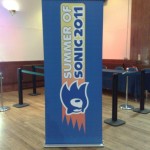 Saturday, June 25th. A thousand-strong horde of Sonic fans descends upon the Camden Centre in London, to celebrate a video gaming icon with music, games, laughs and chilli dogs. So far, so Summer of Sonic, but this was the 20th anniversary show so there had to be something just a bit special going on, and blimey did they ever deliver on that. How? By getting Yuji Naka and Takashi Iizuka to drop by London to enjoy the festivities, do some signings and some Q&A sessions. That is pretty hard to top, ladies and gents, especially when fans were able to quiz the pair on Madonna, the joint American/Japanese development of Sonic 2, and dat barrel. However, Sonic Retro was also able to get a little more into the bargain and snag an interview slot with Naka and Iizuka. Exciting? I thought so.
Saturday, June 25th. A thousand-strong horde of Sonic fans descends upon the Camden Centre in London, to celebrate a video gaming icon with music, games, laughs and chilli dogs. So far, so Summer of Sonic, but this was the 20th anniversary show so there had to be something just a bit special going on, and blimey did they ever deliver on that. How? By getting Yuji Naka and Takashi Iizuka to drop by London to enjoy the festivities, do some signings and some Q&A sessions. That is pretty hard to top, ladies and gents, especially when fans were able to quiz the pair on Madonna, the joint American/Japanese development of Sonic 2, and dat barrel. However, Sonic Retro was also able to get a little more into the bargain and snag an interview slot with Naka and Iizuka. Exciting? I thought so.
Now if you will, allow me to set the scene. Things are behind schedule and everyone is hot and totally knackered, a fact that fellow attendees will attest to. We’re now down to the last interview slot of the day, and another site needs to cram into the session too. We finally get to head in as Jun Senoue takes to the stage to wow everyone downstairs. Still, I know things are going to be at least a little bit good when we’re asked what sites we came from – the mention of our site causes an “Ah, Sonic Retro!” from Iizuka, as he tilts his head back and smiles with a mixture of recognition and amusement. If you were ever in doubt of Retro’s reach, dear reader, that should give you a rough idea of our place in the grand scheme of things.
Then, with little time to spare and more questions than I can possibly ask, we get down to business.
Retro: Naka-san, you joined Sega around the time of its first real console releases, having worked on the SG-1000 and Sega My Card series back in the mid-80s. What was it like to see Sega become a video game publisher that was known all over the world?
Naka: At the beginning, Sega’s real catalyst for success was the arcade, and Sonic pulled it along and really built upon that. Also, the fact that we had hardware and were a first party helped to give us that status in the market, as a global name. So, I feel really happy to be able to be involved, really lucky. It’s really amazing that something created in Haneda, which is not at the centre of Tokyo, sold worldwide.
Hit the post break for the rest of the interview!
